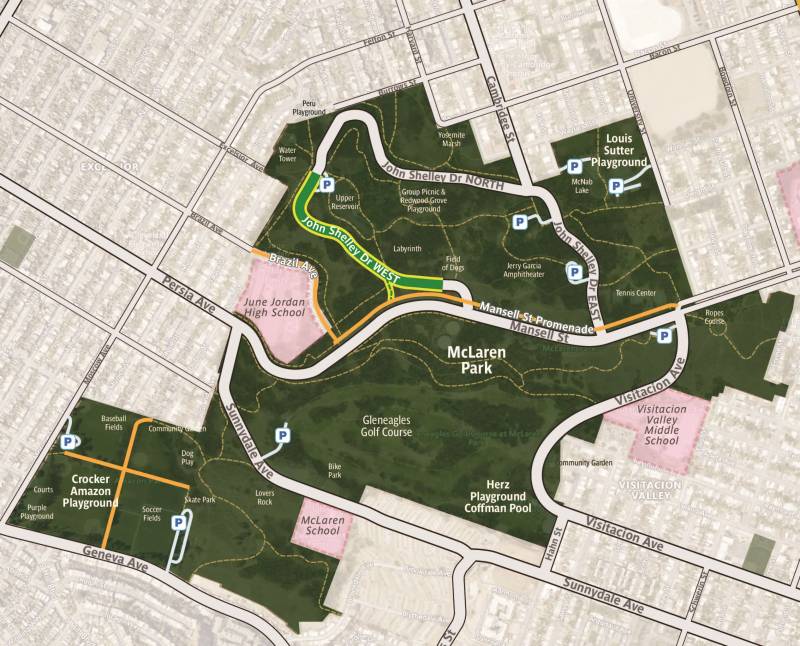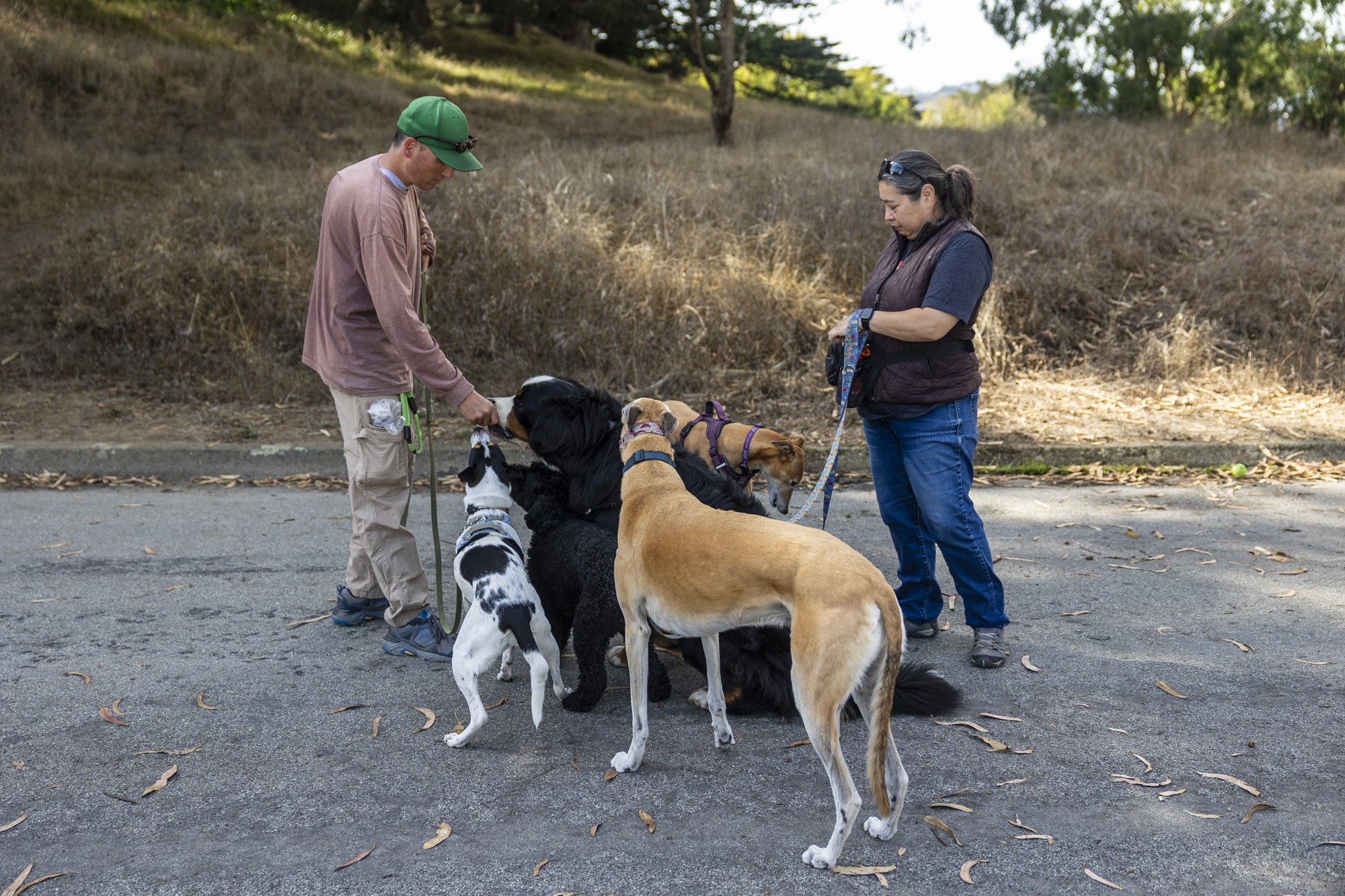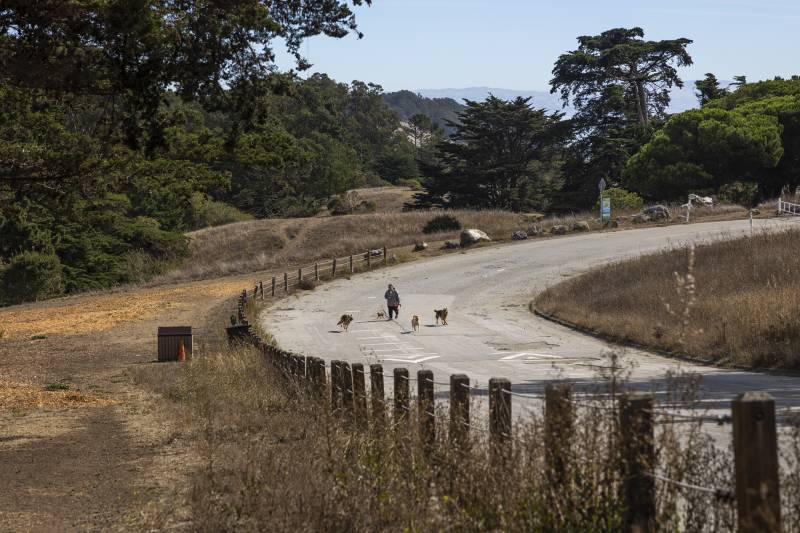Update, 4:30 p.m. Tuesday: The San Francisco Board of Supervisors unanimously approved legislation on Tuesday to permanently restrict cars on a nearly half-mile stretch of Shelley Drive in McLaren Park.
Original story, 7:30 a.m. Tuesday
The San Francisco Board of Supervisors is set to vote Tuesday on a proposal to permanently ban cars on a nearly half-mile stretch of John Shelley Drive in McLaren Park, a sprawling green space in the southeastern part of the city.
In April 2020, at the onset of the pandemic, the city closed much of the northern and western portions of the drive to private vehicles. The following year, it reopened the northern stretch, but continued to block cars from entering the western section of blacktop — between the Upper Reservoir Parking Lot and Mansell Street — which will become a permanent promenade if the legislation is approved.
“This is great and amazing and I think it would vastly improve the park,” said Myrna Melgar, who co-sponsored the legislation, which is backed by Mayor London Breed and appears likely to pass. “I spend a lot of time there because it’s closer to my house than Golden Gate. It’s overdue.”

Earlier this month, before the Land Use and Transportation Committee voted unanimously to advance the proposal to the full board, Brian Stokle, an urban planner with the San Francisco Recreation and Park Department, urged supervisors to approve the permanent ban, arguing that doing so would “create a slower and more walkable park street that’s also safer, more accessible and improves mobility and equity.” At a community meeting on the issue earlier this year, he added, attendees expressed overwhelming support for permanently closing the section of road, which on sunny days offers expansive views of the city’s skyline.
Stokle also noted that an analysis by the San Francisco Municipal Transportation Agency found that closing the stretch of road, which is part of a loop and doesn’t intersect major roadways, had little measurable impact on neighborhood traffic.
In fact, the bid to make the car-free designation permanent has faced little vocal pushback, especially compared to the fervor of last year’s ultimately unsuccessful effort to get vehicles back onto Golden Gate Park’s John F. Kennedy Drive. The Board of Supervisors approved that permanent road closure in May 2022 by a vote of 7–4, despite several of its members arguing that doing so was unfair to people with disabilities and the elderly, and one even calling the ban a form of “recreational redlining” that disadvantaged communities of color who lived far from the park.
But the board’s vote hardly settled the issue. A vociferous group of opponents sponsored a referendum to reverse the legislation, only to have supervisors qualify a competing ballot measure to affirm their decision. In November, city voters went on to approve the permanent road closure by a wide margin.
On a recent weekday morning, a handful of dog walkers — and their sizable canine packs — headed along the car-free section of Shelley Drive, en route to the dog-play area known as “the Field of Dogs.”
For Amy Brown, one such dog walker who visits the park five days a week, permanently closing the road to cars would be a major safety improvement.

“It’s great for the park. I think we get to use all the trails more,” said Brown, who noted that drivers in the park used to throw garbage out of their windows, and sometimes even used the road to do donuts. And motorcyclists often sped through the park and tore across walking trails.
“With the closure, we’ve seen a lot less of that,” Brown said.
But while park visitor Maria da Costa said she supports a vehicle-free stretch of road in the park, she questions the location of the promenade. The section between the blue water tower and the picnic areas, she said, “would have been a better option.”
“I am for the closure being permanent,” she said. “I just think they should have made the closure in a different area because people speed down these streets in the park and they go by the playground and the picnic areas driving too fast.”
KQED’s Matthew Green contributed to this story.
